

The origins of golf are unclear and much debated. However, it is generally accepted that modern golf evolved in Scotland during the Middle Ages. The game did not find international popularity until the late 19th century, when it spread into the rest of the United Kingdom and then to the British Empire and the United States of America.
Origins
A golf-like game is recorded as taking place on 26 February 1297, in the Netherlands, in a city called Loenen aan de Vecht, where the Dutch played a game with a stick and leather ball. The winner was whoever hit the ball with the least number of strokes into a target several hundred yards away. Some scholars argue that this game of putting a small ball in a hole in the ground using golf clubs was also played in 17th-century Netherlands and that this predates the game in Scotland. There are also other reports of earlier accounts of a golf-like game from continental Europe.
In April 2005, new evidence re-invigorated the debate concerning the origins of golf. Recent evidence unearthed by Prof. Ling Hongling of Lanzhou University suggests that a game similar to modern-day golf was played in China since Southern Tang Dynasty, 500 years before golf was first mentioned in Scotland.
Dōngxuān Records from the Song Dynasty (960–1279) describes a game called chuíwán and also includes drawings of the game. It was played with 10 clubs including a cuanbang, pubang, and shaobang, which are comparable to a driver, two-wood, and three-wood. Clubs were inlaid with jade and gold, suggesting chuíwán was for the wealthy. Chinese archive includes references to a Southern Tang official who asked his daughter to dig holes as a target. Ling suggested chuíwán was exported to Europe and then Scotland by Mongolian travelers in the late Middle Ages.
Early golf in Scotland
The modern game of golf is generally considered to be a Scottish invention. A spokesman for the Royal and Ancient Golf Club of St. Andrews, one of the oldest Scottish golf organizations, said "Stick and ball games have been around for many centuries, but golf as we know it today, played over 18 holes, clearly originated in Scotland. The word golf, or in Scots gouf, is usually thought to be a Scots alteration of Dutch "colf" or "colve" meaning "stick, "club", "bat", itself related to the Proto-Germanic language *kulth- as found in Old Norse kolfr meaning "bell clapper", and the German Kolben meaning "mace or club". The Dutch term Kolven refers to a related sport.
The first documented mention of golf in Scotland appears in a 1457 Act of the Scottish Parliament, an edict issued by king James II of Scotland prohibiting the playing of the games of gowf and football as these were a distraction from archery practice for military purposes. Bans were again imposed in Acts of 1471 and 1491, with golf being described as "an unprofitable sport". Mary, Queen of Scots, was accused by her political enemies of playing golf, after her second husband Henry Stuart, Lord Darnley, was murdered in 1567. George Buchanan subsequently wrote that she had been playing "sports that were clearly unsuitable to women". Golf was banned again by parliament under king James IV of Scotland, but golf clubs and balls were bought for him in 1502 when he was visiting Perth, and on subsequent occasions when he was in St Andrews and Edinburgh.
The account book of lawyer Sir John Foulis of Ravelston records that he played golf at Musselburgh Links on 2 March 1672, and this has been accepted as proving that The Old Links, Musselburgh, is the oldest playing golf course in the world. There is also a story that Mary, Queen of Scots, played there in 1567.
The earliest known instructions for playing golf have been found in the diary of Thomas Kincaid, a medical student who played on the course at Bruntsfield Links, near Edinburgh University, and at Leith Links.
H0me page history
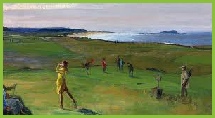
Golf course evolution
His notes include his views on an early handicap system. In his entry for 20 January 1687 he noted how "After dinner I went out to the Golve", and described his Golf stroke:
I found that the only way of playing at the Golve is to stand as you do at fenceing with the small sword bending your legs a little and holding the muscles of your legs and back and armes exceeding bent or fixt or stiffe and not at all slackning them in the time you are bringing down the stroak (which you readily doe) ....
The oldest surviving rules of golf were written in 1744 for the Company of Gentlemen Golfers, later renamed The Honourable Company of Edinburgh Golfers, which played at Leith Links. Their "Articles and Laws in Playing at Golf, now preserved in the National Library of Scotland, became known as the Leith Rules and the document supports the club's claim to be the oldest golf club, though an almanac published about a century later is the first record of a rival claim that The Royal Burgess Golfing Society had been set up in 1735. The instructions in the Leith Rules formed the basis for all subsequent codes, for example requiring that "Your Tee must be upon the ground" and "You are not to change the Ball which you strike off the Tee".
The 1744 competition for the Gentlemen Golfers’ Competition for the Silver Club, a trophy in the form of a silver golf club provided as sponsorship by Edinburgh Town Council, was won by surgeon John Rattray, who was required to attach to the trophy a silver ball engraved with his name, beginning a long tradition. Rattray joined the Jacobite Rising of 1745 and as a result was imprisoned in Inverness, but was saved from being hanged by the pleading of his fellow golfer Duncan Forbes of Culloden, Lord President of the Court of Session. Rattray was released in 1747, and won the Silver Club three times in total.
Early excursions
In 1603 James VI of Scotland succeeded to the throne of England. His son Henry Frederick, Prince of Wales and his courtiers played golf at Blackheath, London, from which the Royal Blackheath Golf Club traces its origins. There is evidence that Scottish soldiers, expatriates and immigrants took the game to British colonies and elsewhere during the 18th and early 19th centuries. The Royal Calcutta Golf Club (1829) and the club at Pau (1856) in south western France are notable reminders of these excursions and are the oldest golf clubs outside of the British Isles and the oldest in continental Europe respectively. However, it was not until the late 19th century that Golf became more widely popular outside of its Scottish home.
The late 19th-century boom
In the 1850s Queen Victoria and Prince Albert built Balmoral Castle in the Scottish Highlands. The railways came to St Andrews in 1852. By the 1860s there were fast and regular services from London to Edinburgh. The royal enthusiasm for Scotland, the much improved transport links and the writings of Sir Walter Scott caused a boom for tourism in Scotland and a wider interest in Scottish history and culture outside of the country. This period also coincided with the development of the Gutty; a golf ball made of Gutta Percha which was cheaper to mass produce, more durable and more consistent in quality and performance than the feather-filled leather balls used previously. Golf began to spread across the rest of the British Isles. In 1864 the golf course at the resort of Westward Ho! became the first new course in England since Blackheath. In 1880 England had 12 courses, rising to 50 in 1887 and over 1000 by 1914. The game in England had progressed sufficiently by 1890 to produce its first Open Champion, John Ball. The game also spread further across the empire. By the 1880s golf clubs had been established in Ireland, Australia, New Zealand, Canada and South Africa. Singapore followed in 1891. Courses were also established in several continental European resorts for the benefit of British visitors.
United States of America
Evidence of early golf in the United States includes an advertisement published in the Royal Gazette of New York City in 1779 for golf clubs and balls, and the notice of the annual general meeting for a golf club in Savannah published in the Georgia Gazette in 1796. However, as in England, it was not until the late 19th century that golf started to become firmly established. Although there are several competing claims to being the oldest club, what is not contested is that in 1894 delegates from the Newport Country Club, Saint Andrew's Golf Club, Yonkers, New York, The Country Club, Chicago Golf Club, and Shinnecock Hills Golf Club met in New York City to form what was to become the United States Golf Association (USGA). By 1910 there were 267 clubs. During the Roaring Twenties the game expanded greatly in popularity and by 1932 there were over 1,100 golf clubs affiliated to the USGA. In 1922 Walter Hagen became the first native born American to win the British Open Championship, signalling the USA's dominance of the game that has yet to be seriously challenged. The expansion of the game was halted by the Great Depression and World War II, but continued in the post war years. By 1980 there were over 5,000 USGA affiliated clubs, and today the total exceeds 10,600.
Japan
After the Meiji restoration of 1868 Japan made a concerted effort to modernize its economy and industry on western lines. Japanese came to Europe and America to establish trade links and study and acquire the latest developments in business, science and technology, and westerners came to Japan to help establish schools, factories, shipyards and banks.
In 1903 a group of British expatriates established the first golf club in Japan, at Kobe. In 1913 the Tokyo Golf club at Komazawa was established for and by native Japanese who had encountered golf in the United States. In 1924 The Japan Golf Association was established by the seven clubs then in existence. During the 1920s and early 30's several new courses were built, however the great depression and increasing anti-Western sentiment limited the growth of the game. By the time of the Japanese attacks against the USA and British Empire in 1941 there were 23 courses. During the subsequent war most of the courses were requisitioned for military use or returned to agricultural production.
In the postwar period, Japan's golf courses came under the control of the occupying forces. It was not until 1952 that courses started to be returned to Japanese control. By 1956 there were 72 courses and in 1957 Torakichi Nakamura and Koichi Ono won the Canada Cup (now World Cup) in Japan, an event that is often cited as igniting the post-war golf boom. Between 1960 and 1964 the number of golf courses in Japan increased from 195 to 424. By the early 1970s there were over 1,000 courses. The 1987 Resort Law that reduced protection on agricultural land and forest preserves created a further boom in course construction and by 2009 there were over 2,400 courses. The popularity of golf in Japan also caused many golf resorts to be created across the Pacific Rim. The environmental effect of these recent golf booms is seen as a cause for concern by many.
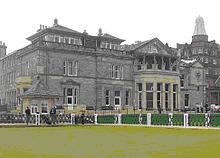
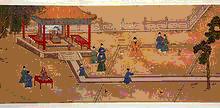
The Royal and Ancient Golf Club of St Andrews
Ming Dynasty emperor Xuande (r. 1425–1435)

Equipment development


Golf origins

Golf clubs components
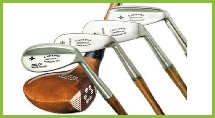
Golf set
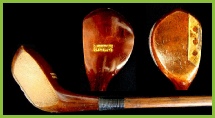
Golf woods
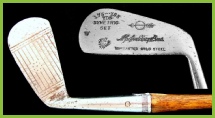
Long and mid irons
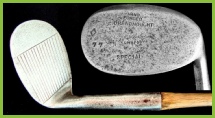
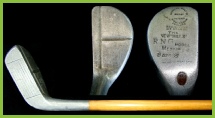
Golf putter
Short irons and wedges
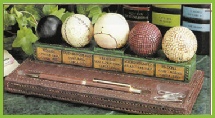
Golf balls

Glossary